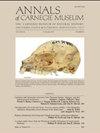Craniomandibular Anatomy of the Subterranean Meridiolestidan Necrolestes patagonensis Ameghino, 1891 (Mammalia, Cladotheria) from the Early Miocene of Patagonia
IF 0.9
4区 地球科学
Q4 PALEONTOLOGY
引用次数: 27
Abstract
ABSTRACT Among the collections made during the 1896–1899 Princeton Expeditions to Patagonia are three specimens with partial crania and postcrania of Necrolestes patagonensis Ameghino, 1891, from Santa Cruz Province, Argentina. Necrolestes has anatomical specializations found in extant subterranean mammals, and other features identifying Necrolestes as a late Miocene member of the South American Meridiolestida, a non-therian clade that otherwise is limited to the Cretaceous and Paleocene. Anatomical aspects of the three Princeton specimens have been reported previously but they are more fully described here after additional preparation. The most novel discoveries concern specializations of the snout that help identify Necrolestes as a head-lift digger, as are the extant African golden moles and Australian marsupial moles. As in other meridiolestidans and most non-therian mammals, Necrolestes has a septomaxilla at the external nasal aperture. However, the septomaxilla of Necrolestes has structures that buttress an internarial bar and what we interpret as ossified external nasal cartilages, a remarkable adaptation for digging not known in any extant subterranean therians. The upturned snout of Necrolestes produces a shovel effect and also is known in two lineages of subterranean placentals, namely Oligocene palaeanodonts and Miocene proscalopid soricomorphs. The braincase, ear region, and basicranial vasculature are built on a pattern like that in other non-therian mammals, but additional spaces in the squamosal and exoccipital bones increase the volume of the middle ear, which in extant therians is associated with enhancement of low-frequency hearing, another subterranean adaptation. Our findings reinforce the meridiolestidan affinities for Necrolestes and reconstruction of its subterranean habit.巴塔哥尼亚早中新世地下Meridiolestidan Necrolestes patagonensis Ameghino, 1891(哺乳纲,枝门目)的颅颌解剖
在1896-1899年普林斯顿大学考察巴塔哥尼亚期间收集的标本中,有阿根廷圣克鲁斯省1891年的巴塔哥尼亚Necrolestes patagonensis Ameghino的部分颅骨和后颅骨标本。在现存的地下哺乳动物中发现了Necrolestes的解剖学特化特征,以及其他特征,这些特征表明Necrolestes是南美洲子轮动物的中新世晚期成员,这是一个非兽类的分支,否则仅限于白垩纪和古新世。三个普林斯顿标本的解剖方面以前已经报道过,但在这里经过额外的准备后,它们更全面地描述了。最新颖的发现与鼻子的特化有关,这有助于识别Necrolestes是一种抬头挖掘者,就像现存的非洲金鼹鼠和澳大利亚有袋类鼹鼠一样。与其他子午线动物和大多数非兽类哺乳动物一样,坏死性动物在鼻外孔处有一个鼻中隔腋窝。然而,Necrolestes的鼻中隔腋窝具有支撑内部筋的结构,我们将其解释为骨化的外部鼻软骨,这是一种对挖掘的显著适应,在任何现存的地下恐龙中都不知道。Necrolestes的上翘鼻部产生铲状效应,在渐新世古齿兽和中新世前鳞兽这两个地下胎盘谱系中也有发现。脑壳、耳区和颅底脉管系统的构造模式与其他非兽类哺乳动物相似,但鳞片和枕外骨中的额外空间增加了中耳的体积,这在现存兽类中与低频听力的增强有关,这是另一种地下适应。我们的发现加强了Necrolestes的经络亲和性和其地下习性的重建。
本文章由计算机程序翻译,如有差异,请以英文原文为准。
求助全文
约1分钟内获得全文
求助全文
来源期刊

Annals of Carnegie Museum
综合性期刊-动物学
CiteScore
2.50
自引率
18.20%
发文量
4
审稿时长
>12 weeks
期刊介绍:
Annals of Carnegie Museum is a quarterly journal that publishes peer-reviewed short and medium-length original scientific contributions in organismal biology, earth sciences, and anthropology, in 40 by 52.5 pica format (168 by 220 mm or 6-5/8 by 8-5/8 inches). Subject matter must be relevant to Carnegie Museum of Natural History scientific sections or Powdermill Nature Reserve (PNR), preferably with connection to the Carnegie collection and/or personnel. Carnegie Museum staff and research associates receive publication priority, but others are encouraged to submit papers, especially those manuscripts explicitly based on the Carnegie collection.
 求助内容:
求助内容: 应助结果提醒方式:
应助结果提醒方式:


